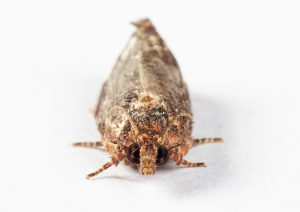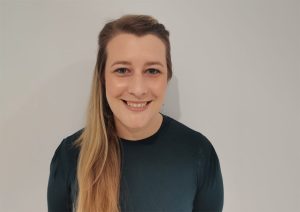
The false codling moth genome sequence
Paving the way for next-generation pest control. By Anna Mouton.
“There’s been rapid growth in pest control methods that are based on genome information,” says Dr Minette Karsten, postdoctoral researcher with the Applied Physiological Ecology Laboratory within the Department of Conservation Ecology and Entomology at Stellenbosch University. She is part of a team — lead by Prof. John Terblanche — that is sequencing the genome of false codling moth. The project is funded by Hortgro.
“Having a genome sequence facilitates an incredible number of downstream applications that we simply can’t access at present,” Karsten explains. “So our idea is to create a genomic toolkit that we — and others — can bring to bear on questions for which we currently don’t have answers.”
The project kicked off last year. Samples of DNA have already been extracted from false codling moths and are being processed by Macrogen, a biotechnology company that specialises in genome sequencing. Karsten and her colleagues will use the raw data provided by Macrogen to assemble the complete sequence.
A genome sequence is basically a series of characters where each character represents one of the four bases that make up DNA — think of it as an alphabet with only four letters. Genes are strings of bases that spell out instructions for making proteins. Organisms need thousands of different genes to make the thousands of different proteins that are the building blocks of their bodies.
Karsten won’t know how big the false codling moth genome is until she receives the sequencing data, but it’s likely to be similar in size to that of other closely related moth species. The genome of codling moth was recently sequenced and that ran to about 773 million base pairs. To put this in perspective, if bases were letters of the alphabet, the codling moth genome would be roughly the same length as 120 sets of the entire Harry Potter series.
Go with the gene flow
One of the first uses of the genome will be the development of microsatellite markers to study gene flow in false codling moth. Genomes don’t only consist of instructions for making proteins — they also contain large sections of non-coding DNA. Non-coding DNA is often made up of short sequences that repeat several times. These are called simple sequence repeats or microsatellites.
Microsatellites can be used as markers to measure how closely individuals are related. Different species have different sets of microsatellites throughout their genome. Individuals within a species have the same microsatellites but the number of sequence repeats of a given microsatellite will vary. Patterns of variation allow researchers to determine ancestry and differentiate subpopulations.
“The question is whether there are subpopulations of false codling moth in South Africa,” Karsten says, “and if so, are they geographical? Or do they relate to host preference?” These findings would have important implications for control. “If we see that there’s geographical separation, then we can treat certain areas as discrete management units — basically islands — for example when applying sterile insect technique.”
Karsten describes how microsatellite markers will indicate whether gene flow is occurring between different areas and hosts. “If, for the sake of illustration, we find that the Eastern Cape has its own population and now moths arrive from the Western Cape, but Eastern Cape moths don’t go the other way, you can ask how this happens. Are we exporting something to the Eastern Cape?”
The team also hopes to obtain samples of moth-infested fruit so that they can use microsatellite markers to examine questions around host preference. “If a false codling moth emerges from say, an orange, will it always return to oranges regardless of what other fruit are available?” Karsten wonders. “There is some evidence for this but not enough — we don’t know the answer.”
Putting false codling moth to flight
Erika Huisamen is the doctoral student working on the gene flow project, for which she has been gathering a wide range of infected fruit and trap catches from different areas. In addition, she is studying the biology of false codling moth. Her laboratory is filled with cages of adult moths drinking sugar water while awaiting their turn to contribute to science.
“I’m doing flight ability experiments in the insectarium. I’m seeing whether the moths have stronger or weaker flight when they’ve had a certain temperature stress,” Huisamen says. She has been exposing fifth-instar larvae to different temperatures and allowing them to pupate. Huisamen then tests the adults for dispersal ability.
Laboratory studies on pesticide exposure at different temperatures are also planned. This will use technology called transcriptomics. Transcriptomics identifies all the messenger RNA in a cell. “DNA is the plan — how things are put together,” Karsten explains. “To get from DNA to proteins — the physical components of biological systems — you need messenger RNA. The messenger RNA carries the message of which proteins need to be made.”
Researchers can tell which genes are being expressed by looking at what messenger RNA has been produced. “So we can change various things and see how that changes gene expression. For example we can see which genes are upregulated in response to sublethal pesticide concentrations,” Karsten says. “One major focus of this project is to identify the genes responsible for pesticide resistance.”
Understanding the genetic basis of pesticide resistance is just one way in which this work could help growers in the future. “There are many next-generation novel control methods that are up-and-coming,” Karsten says. She points toward the example of research to develop mosquitos that spread genes which cause the population to collapse.
“At this point we won’t be developing those sorts of techniques,” Karsten cautions. “But we are sequencing the genome which will enable us to do many other things that we can’t do without it.”
Image: Dr Minette Karsten — left — and Erika Huisamen next to a cage of false codling moths.
Supplied by Anna Mouton.






